Aoife Ward and Marcus Looney, Digital Marketing Team
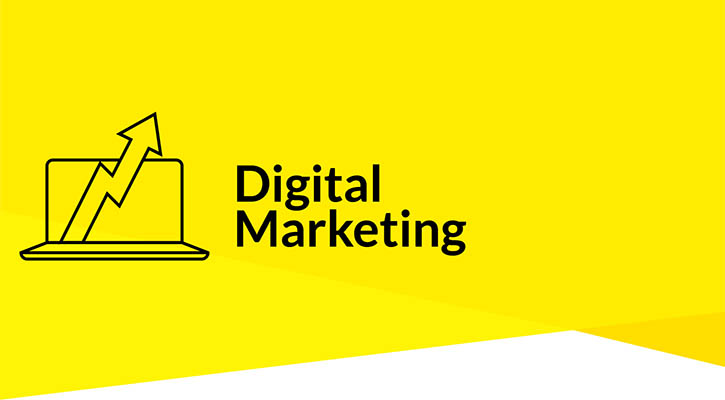
We are working hard to make sure that HSE.ie is the trusted source for all online health-related information in Ireland. We do this by working with our clinical colleagues to ensure all our information is accurate and up-to-date. Our content design team make sure the information is easy to understand and work with the digital marketing team to ensure our content appears at the top of search results pages for online health-related queries.
During the pandemic, the digital marketing team played an important role in informing what content we needed to develop to respond to what people were searching for. Taking time to use some of the free tools provided by Google we were able to:
- identify what content people were looking for
- make it easier for people to find content
Finding out what people are searching for and viewing online
A Google search is the first thing many people do when it comes to their health. 7% of all Google's daily searches are health-related. This amounts to 70,000 health-related searches worldwide every minute and shows how important it is for our content to be visible in Google.
Google Trends
Google Trends is an online tool by Google that analyses the popularity of top search queries in Google Search in different countries and languages.
You can use it to compare the search volume of different search queries over a specific period of time. We use Google Trends to monitor interest in a range of COVID-19 related searches in Ireland, to see day-to-day spikes and related searches.
Using Google Trends during the pandemic has highlighted how quickly interest in specific topics can change.
At the start of the pandemic, people were just typing ‘coronavirus’ into Google search. When the virus was detected in Ireland, people started searching for more specific terms, such as ‘symptoms of coronavirus’, ‘how coronavirus is spread’ and ‘coronavirus update’.
As time went on, the term ‘COVID-19’ started to appear in search data. Eventually, searches for ‘COVID-19’ outnumbered searches for ‘coronavirus’.
New search terms emerged regularly, as people began to use words that were not commonly used before. Following some of the government announcements, people were searching for terms like ‘self-isolation’, ‘social distancing’, ‘quarantine’ and ‘cocooning’ for the first time. Some words and terms have peaked briefly, for others, interest has remained high over time.
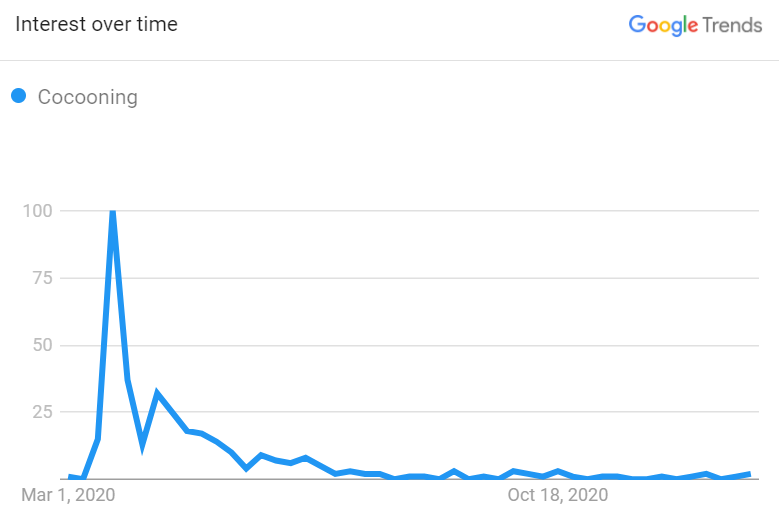
Google Trends data showing a sharp increase in searches for ‘cocooning’ from March 2020
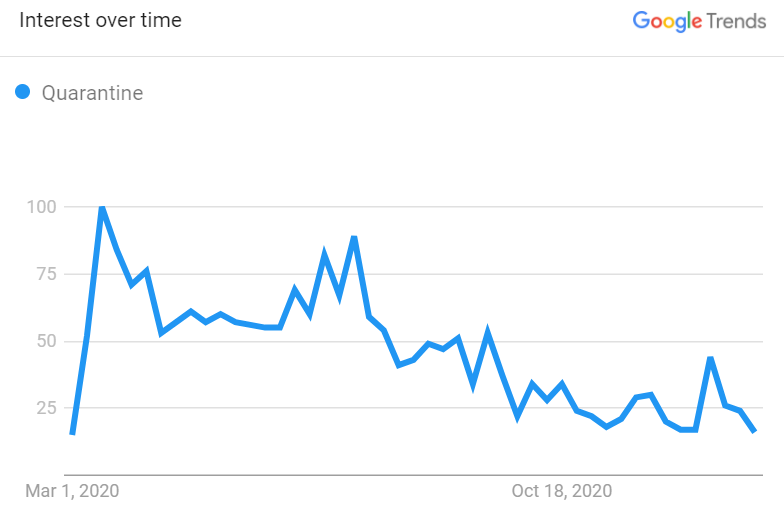
Google Trends data showing a sharp increase and continued interest in searches for ‘quarantine’ from March 2020
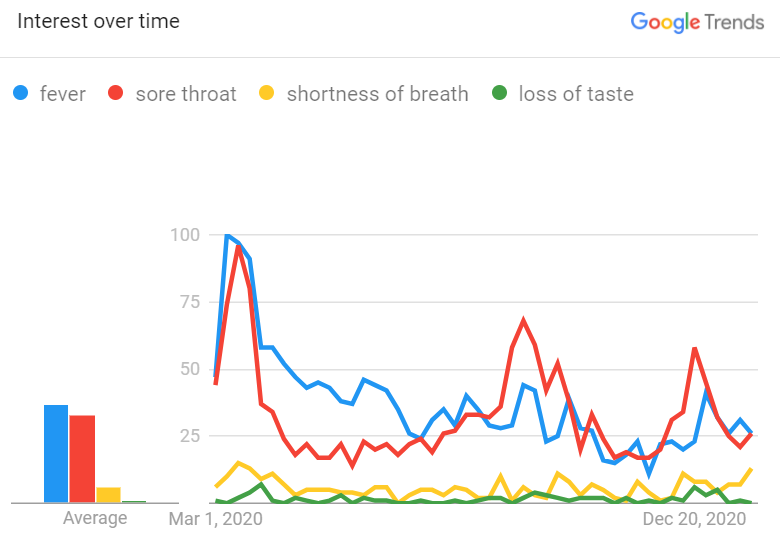
Google Trends data showing the popularity of different symptoms
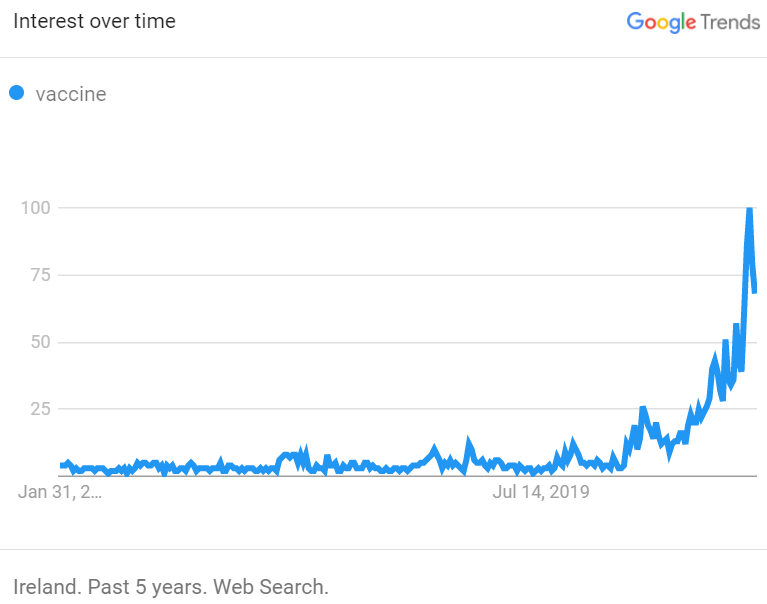
Google Trends data showing interest in ‘vaccine’ has reached an all-time high
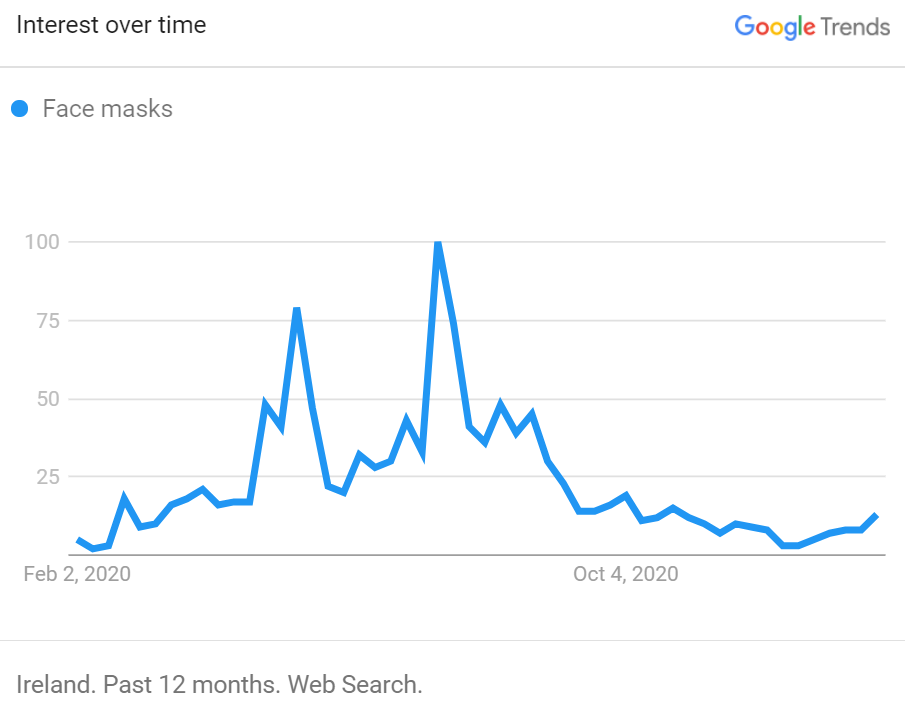
Google Trends data showing interest in ‘face masks’ over the last 12 months
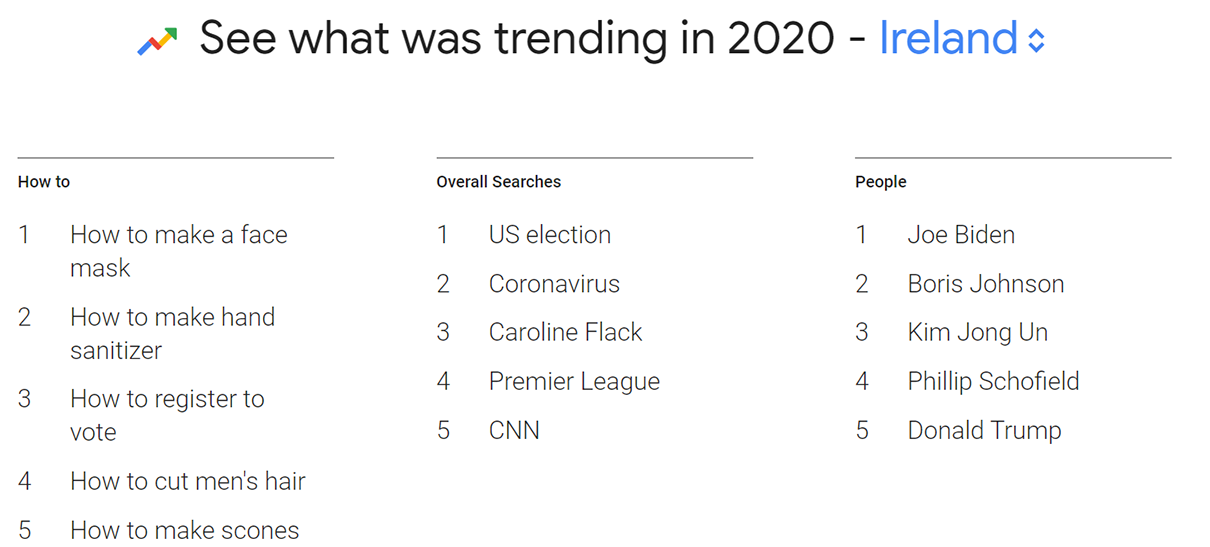
Google Trends data showing an overview of search interest in Ireland in 2020
Using Google Trends helps us to identify information that we need to add to the website and promote on other channels. An example of this was in April 2020 when we had a large number of searches for 'hayfever v coronavirus'. We made the content team aware of this. They consulted with our COVID-19 clinical experts, and as a result, the content team produced information about this for the website.
Google Analytics
We use Google Analytics to analyse website traffic. We only capture anonymous information and give people control over whether we can include their visit in our stats, in line with GDPR.
It allows us to see website activity, for example:
- the length of time people stay on specific pages
- how many pages people visit
- where people come to the site from
- where people go after visiting specific pages
- what the least popular and most popular pages are
We had a huge amount of traffic to HSE.ie in 2020. The COVID-19 content alone had 21 million visitors. To put this into context, in 2019, visitors to the entire HSE.ie website was 11 million.
16 of March 2020 was the busiest day ever for HSE.ie, with 850K visitors. This was a 400% increase on the previous Monday.
The COVID-19 landing page was the most viewed page in 2020, with 8.5 million views. To put this into context, the most viewed page in 2019 was the HSE.ie job search page with 2.7 million views.

Monthly visits to the COVID-19 content on HSE.ie in 2020
Due to the significant increase in traffic since March 2020, we assess the performance of the COVID-19 content on a daily basis. We monitor what the most viewed COVID-19 pages and related pages are. This helps us to react quickly to activity on the site and take any necessary action, for example, improving the internal search.
Optimising internal search on HSE.ie
In 2020, we had a huge increase in the number of people using the internal search box on HSE.ie.

HSE.ie search box
HSE.ie has a wide variety of topics and about 30,000 pages. The search box is an essential navigation tool that helps users quickly find what they need.
Internal search statistics in 2020
- 1.5M unique internal searches - a 68% increase compared to 2019.
- 1.1 million website sessions that included the use of the search box - a 53% increase compared to 2019.

Sessions where the search box was used in 2019 compared to 2020
Monitoring site search
Because of the increased use of the internal search, we allocated more time to monitor and improve it and implemented some new processes.
Monitoring the internal search helps us to:
- identify problems people have when searching for information internally
- fine-tune the results page for searches related to COVID-19
- understand search behaviour
- promote high-value content - to make it easier for users to find the right information
- identify user intent
With the insights from this, we used features such as 'synonyms' and 'search ads' to improve the user experience.
The synonyms feature lets us map incorrect spellings to the correct words. We can also link words or terms with similar meanings. This means we can give people the content they are looking for.
We used search ads in our internal search results to promote relevant information and solutions.
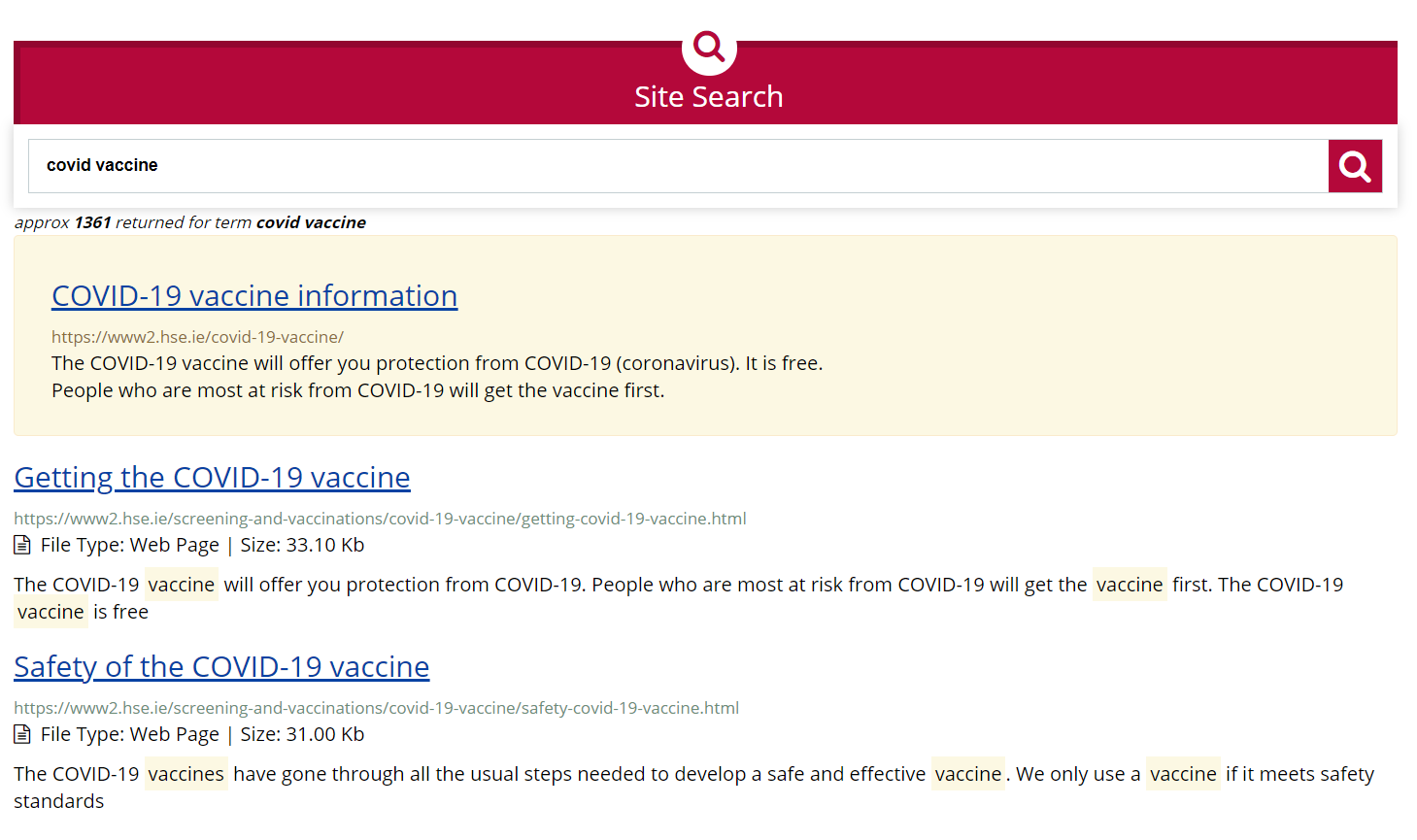
Internal search ad for COVID-19 vaccine
Making content available in search as it goes live
For content as time-sensitive as the COVID-19 content, we have to make sure it is available in our site search as soon as it is published on the site. We can’t afford to wait for the usual automatic search index updates. Frequent changes to COVID-19 information and public health advice mean we need this new content to appear in search as soon as possible.
Coping with new words and terms
When the term ‘cocooning’ was first used in a government announcement, it put a strain on the website and the internal search, as people tried to find information about cocooning.
It wasn’t a term that had been used before in relation to COVID-19 content, so when people searched for it, other non-relevant content was being returned. We had to respond to this quickly, in real-time. To do this, we directed the search term ‘cocooning’ to our COVID-19 content, while the content team updated the existing content and drafted specific content explaining the meaning of the term.
Improving internal search
Analysing the internal search data provided many useful insights. For example, identifying searches for COVID-19 information published on other websites. One example was certain information relating to COVID-19 restrictions published on gov.ie. To deal with this, we now link to gov.ie from our search results for various COVID-19 topics. This means our users get the COVID-19 information they need, even if it is not on our site.
Feedback from users
In May 2020, we conducted an independent survey among 2,200 of our website users. One of the areas we asked about was the internal search on HSE.ie. Users reported a customer-centric index (CCI) score of 75% - well above the average score of 48% recorded in a similar audit of 332 other websites, across all sectors and industries.
Paid search campaign on Google
Paid search is a form of digital marketing where search engines such as Google allow advertisers to display ads at the top of the Google search results pages. For an ad to appear, you bid on specific keywords and phrases to trigger your ad.
At the start of the pandemic, our paid search ads focused on a medical professional audience, because we were not sure what kind of search interest there would be. At that stage, we bid on keywords such as ‘coronavirus algorithm’ and ‘coronavirus patients’.
As the situation evolved, our paid search ads shifted to more general COVID-19 related keywords, for example:
- symptoms of covid
- covid treatment
- covid test
- close contacts
- self-isolation
- restricted movement
- covid tracker app

Google paid search ads for ‘COVID-19 symptoms’ and ‘COVID-19 testing’
The paid search ads appeared in 6 million searches throughout 2020 and generated 629K visits to our COVID-19 content.
Support from Google
Google gave us a grant for Google Ads as part of their Crisis Response Programme. This strengthened our search visibility and helped to combat misinformation about COVID-19.
They also featured HSE.ie in their range of COVID-19 information panels. This generated a huge amount of additional traffic to our website.
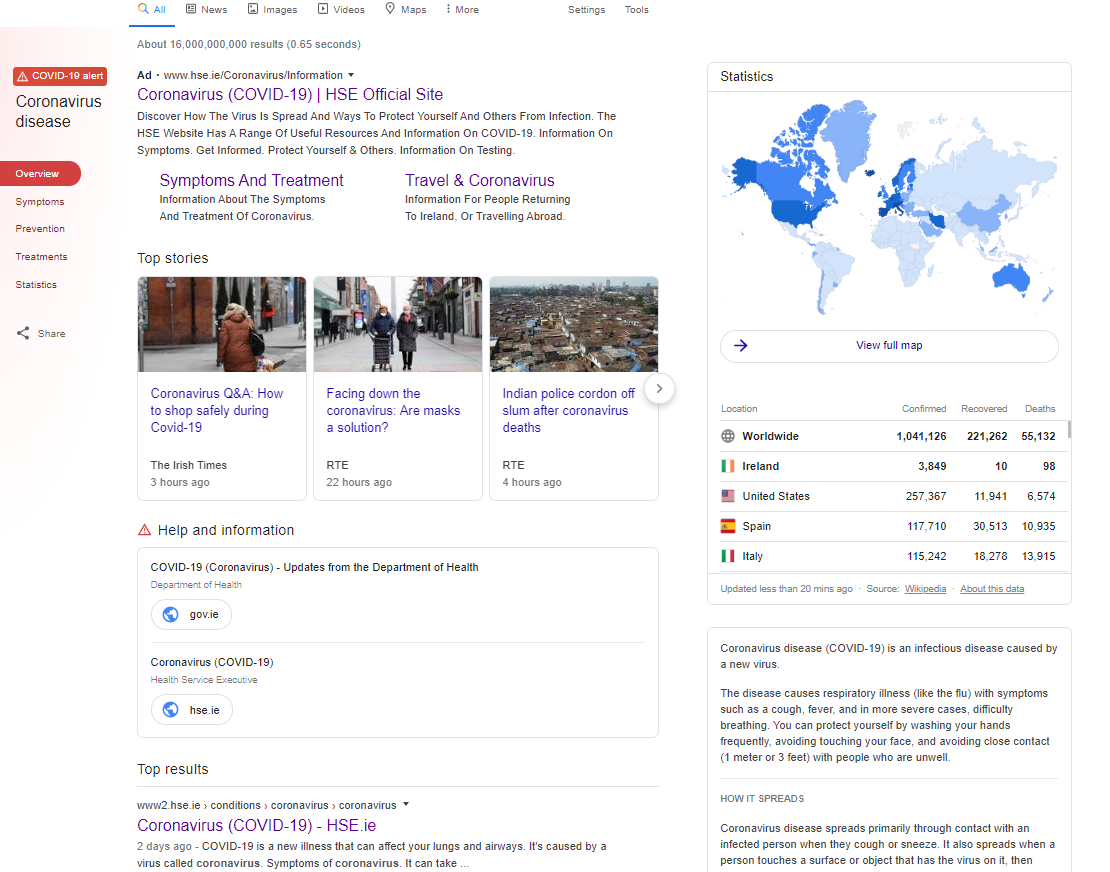
HSE.ie featured in Google's ‘Help and information’ panel for COVID-19 related searches
Looking ahead
2021 brings the launch of the COVID-19 vaccine and a new set of challenges. Search interest will undoubtedly continue to change at speed.
Visibility in Google search and working on our internal search will continue to be an integral part of our work.